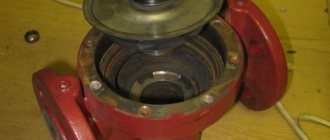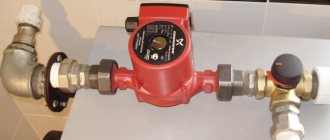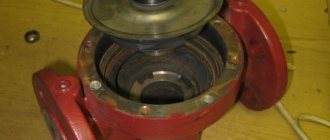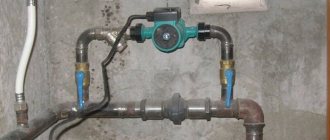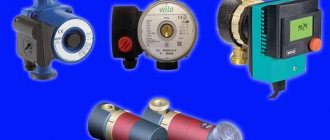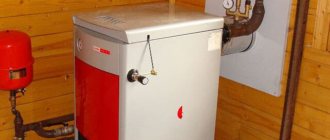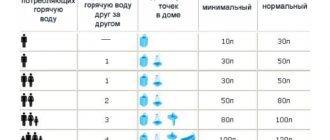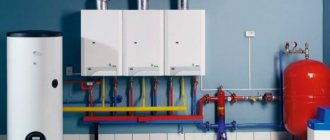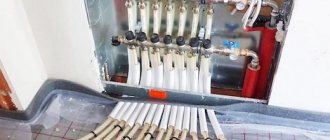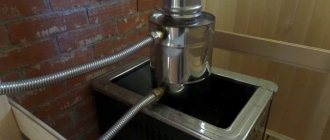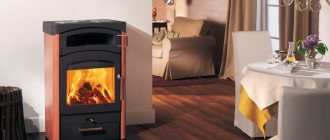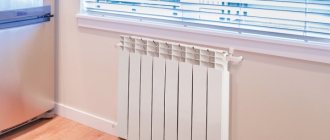Do-it-yourself repair of a heating circulation pump
The efficient functioning of the heating system in a cottage or country house is impossible without a circulation pump. Its uninterrupted operation guarantees that residents will be comfortable indoors during the cold season.
Circulation pump in the heating system
A heating circulation pump is considered reliable equipment that is easy to maintain. By following operating rules and performing timely preventive maintenance, you can minimize the likelihood of malfunctions. If malfunctions do occur, most of them do not pose a problem even for a technician with little experience. Repairing a heating circulation pump with your own hands is not difficult; it is enough to have general knowledge about the design of such equipment.
Setup and commissioning
Commissioning work after installing the circulation pump is not difficult, but must be carried out in a certain order.
- The pump is mounted in the bypass or embedded in the return or supply pipe.
- The device is connected to the electrical network.
- The heating system is filled with water.
- Air pockets are removed by opening shut-off valves on specially made bends or Mayevsky taps installed on heating radiators.
- Air is removed from the circulation pump housing by opening the valve and unscrewing the screw on the device housing cover.
As soon as water begins to come out of the special outlet of the pump, the device is ready for operation. After this, it is enough to start the heating boiler, check the passport to see what speed is best to turn on the heating pump, set the optimal mode and adjust the pressure parameters in the system during the heating process of the coolant.
Rules for operating circulation pumps
The circulation pump can last long enough only if the following series of rules are observed:
- The pump can only be started if the system is filled with coolant;
- The pump should not operate when there is no supply;
- The volume of pumped liquid must correspond to the range that the pump is able to process, otherwise the equipment will wear out too quickly (you can find out the required value in the technical documentation for the pump);
- To prevent the pump from being subjected to oxidation during the warm season, you need to run the heating system for 20 minutes at least once a month;
- The temperature of the liquid pumped by the pump should not be higher than 65 degrees - exceeding this level will lead to the precipitation of solid salts.
There are two types of pumps on the market - “dry” and “wet”. The classification depends on whether there is direct contact between the rotor of the device and the pumped medium. For dry pumps, high noise levels are common. The thing is that such devices are equipped with a fan, which makes a lot of noise during operation, so such equipment is not used in private homes.
Of course, sometimes developers make a mistake (sometimes deliberately, sometimes not) and install a pump with a dry rotor in a private house. Typically, the main argument of such developers is the high efficiency of such equipment - and they prefer to remain silent about the main drawback, which is that the heating pump makes too much noise. In this case, the only way to solve the noise problem is by high-quality sound insulation of the room, or by replacing the pump with a more suitable one.
In wet pumps, the rotor is constantly located inside the pumped medium, which also ensures cooling of the working elements of the equipment. There is no fan in these devices, so they do not make noise during operation, and they can be safely installed in residential buildings.
You can first guess about some problems with pumping equipment by the various sounds that it begins to make. If the heating circulation pump is noisy, you need to figure out what exactly the problem is and try to fix it.
Operation
A large amount of data is presented on the operation and principles of installation of devices for forced liquid supply in systems. However, figuring this out on your own can be difficult. You must follow the manufacturer's instructions. The block can be placed on the back of the conductive system, which can lead to the following consequences:
- During transmission, the fluid is significantly hotter, which prevents the pump from functioning.
- The density level of warm water is lower than that of cold water.
- This increases the pressure on the pipe walls. It also simplifies the operation of overclocking equipment.
In some rooms with installed heating equipment that heats the liquid for supply through pipes, the typical placement of the circulation pump is return. In this case, the method is the only correct one in this situation, since it is possible not to take into account centrifugal-type equipment that can be installed in the outlet pipeline.
In the event of an emergency, when the steam pressure level increases significantly, a valve with a safety function begins to open, which is required to remove the excess fraction. If the opening degree is insufficient, the pressure continues to decrease, a decrease in the indicator is ensured, after which the boiler body may rupture.
Based on the experience of specialists, we can say that 5 minutes or more after the start of heating the premises, the safety valve begins to operate. When installed on the back of the pipeline, steam does not reach the valve, and the time before failure increases up to 4 times. By installing a check valve in the event of an unforeseen incident, you can delay the onset of the consequences of the accident and have time to take action.
How much does it cost to install a heating system pump?
All this is not that expensive, and even more so, the purchase of a pump more than pays for itself after just a few months of use, about a couple of months of the heating season. And then there’s pure savings. It is comparable to the unregulated costs of gas and electricity. A circulation pump for heating a private house can cost from 1,500 rubles. up to 20,000 rub. Installing a circulation pump for heating can cost from 500 rubles. and higher.
Why do you need to install a heating pump?
Firstly, this will allow the batteries to warm up immediately after being connected to the power grid, in contrast to natural circulation, where heating of the heating system takes quite a long time.
Secondly, even if the pipes are laid with a negative slope, the circulation of water with uniform heat distribution is inevitable, due to which the temperature of the heating radiators will be equalized.
Thirdly, effective removal of air jams. Due to the accelerated circulation of the coolant, all air is removed from the heating system in a matter of minutes. But this is often accompanied by the sound of water running through the pipes, which can be annoying.
Fourthly, some heating system configurations will not be able to operate without a circulation pump due to high resistance in the pipelines. This is a system of warm walls, a system of warm floors, combined heating systems with heating collectors.
Selecting the right unit
Installing a pump with a high efficiency factor can lead to an increase in the amount of energy consumed, excessive noise, and wear of the device parts. At the same time, “wet” type pumps are not able to cope with the task of heating large areas due to the low power of the equipment. Modern heating circulation pumps have both manual and automatic modes for controlling the speed of rotation of the motor shaft.
High power factor is achieved at maximum shaft speed. Equip circulation pumps with thermal valves, this will allow you to regulate the heat in the room. When the temperature rises, the valve closes. Which leads to an increase in hydraulic resistance and, as a result, pressure increases. Noise appears, which can be eliminated by moving the equipment to low speeds. But there are pumps with built-in electronics that are able to regulate pressure depending on the amount of water.
How to install a heating pump?
When purchasing, you should pay attention to the presence of different threads included with the pumping equipment. If not included, you will have to choose them yourself. Cleaning filters and a check valve in accordance with the thread diameters will also be needed. In this case, you can do without adapters. For work, as a rule, you need wrenches of sizes 22-36 or adjustable wrenches, shut-off valves and a bypass - a small piece of pipe. And, in accordance with the rules that are included in the box of the purchased device, choose a place for installation.
The video shows what keys we use.
Selecting a pump insertion location
Previously, it was necessary to install equipment only in the return line. It was believed that such a system prolongs the life of the stuffing box system, rotors, and bearings. And now, the position of the pump in space does not play a special role: it can be installed both on the supply pipeline and in the return line. This is explained by the fact that modern heating system pumps do not suffer from contact with hot water. It is best to install the pump next to the heating collector.
Installation of a circulation pump in a heating system
Before installation, you must carefully read the instructions supplied with the equipment, which will allow you to understand the basic rules. The most important detail during installation is the correct position. Namely, the heating system pump must be positioned horizontally to avoid air pockets, which will leave the parts without lubrication and lead to overheating of the motor. And, accordingly, this can lead to further damage to the circulation pump. An arrow is placed on the outer part of the equipment indicating in which direction the coolant should move.
Video about the heating circulation pump in the Viessmann Vitopend 100 boiler.
A filter is installed in front of the pump to trap contaminants. If they get inside the circulation pump, parts may be damaged. Use a regular dirt filter. The filters are marked with an arrow, which indicates the direction of coolant flow in the heating circuit. Do not ignore the direction of the arrow, otherwise you will have to clean, or change if broken, the sump and pump.
Optimal pump speed
The task of a heating system with pump circulation is to reliably deliver coolant to all consumers of the system, including the furthest radiators. For this to happen effectively, the pump must create the pressure necessary for this: the designers calculate it, taking into account the hydraulic resistance of the pipes. Most often, household pumps have 3-7 rotor speeds, which allows you to increase or decrease work productivity.
The easiest way to select the optimal speed of the circulation pump:
- The heating system must be brought into operating mode.
- Measure the pipe surface temperature before and after the boiler using a laser surface thermometer (pyrometer).
- If the temperature difference is more than 20 degrees, the rotor rotation speed must be increased.
- If the difference is less than 10 degrees, the flow rate must be reduced. The optimal difference between the supply and return heating levels is approximately 15 degrees.
The pyrometer need not be used when the supply and return pipes are equipped with thermometers. If, with the help of adjustments, it is not possible to achieve the required temperature difference of 10-20 degrees, this indicates low efficiency of the system. The cause is most often an error in the selection of the circulation apparatus. Too low a return water temperature provokes an increase in the load on the boiler and an increase in energy consumption. Very hot water circulates too quickly to transfer heat to the heaters.
How to disassemble a heating circulation pump with your own hands
To repair the circulation pump, it is necessary to dismantle it and disassemble it thoroughly.
p, blockquote 25,0,0,0,0 —>
Initially, the device must be disconnected from the electrical network. To disconnect the cable from the terminal box, you must remove the housing from the device's power supply. Then you need to shut off the water supply through the side valves and drain the remainder in the system. Next, you need to unscrew the pump with a hex screwdriver.
p, blockquote 26,0,0,0,0 —>
You may encounter a problem when the bolts are stuck. They need to be moistened with WD-40 and after 20-30 minutes try to unscrew them again.
After dismantling is completed, it is necessary to remove the cover of the device. Below it is a rotor with a wheel and blades. You need to remove the rotor, which is usually secured with bolts. This will give you easy access to the internal parts of the pump. Then you should carefully inspect the device and troubleshoot any problems.
p, blockquote 28,0,0,0,0 —> p, blockquote 29,0,0,0,1 —>
Summarizing all of the above, it is worth noting once again that the circulation pump is a very important element of the heating system, which is assigned serious functions. That is why it is very important to monitor its operation and carry out regular maintenance. In the event of malfunctions and malfunctions, you need to immediately take the necessary measures, otherwise you can start and your unit will simply fail.
Filter installation
To increase the service life of the device, it is necessary to prevent contamination of the liquid. Otherwise, small parts may break and you will have to repair the equipment again. A dirt filter installed in front of the pump inlet will help avoid this. To do this, you will have to disassemble the assembled system, and then install the equipment on the incoming part. In this case, debris will settle through the pipe, which will need to be cleaned regularly.
It is up to the owner to repair or replace the forced circulation pump. However, due to the large number of small parts, they are much easier to replace. To do this, you will have to disassemble the system, after which the pump can be replaced.
Average score of ratings is more than 0
Share link
Comments There are no comments yet, but you could be the first...
Preparing the pump for the heating season
To ensure that your heating system does not fail during the winter, it is necessary to check the operation of the entire system, and in particular the circulation pump, before the start of the heating season.
It is necessary to check the serviceability of the device:
- There should always be lubricant on the gasket and pipes. If it has dried out, then it is necessary to lubricate the elements again; It is necessary to check the mesh filter. It often becomes dirty and interferes with the normal operation of the pump. If you notice blockages, you need to clear them;
- The circulation pump must be connected to the pipelines correctly. The best installation option would be in front of the heating boiler. With this arrangement, the formation of air pockets is minimized;
- The correct connection of heating equipment to the network can be checked with a special tester;
- Before the start of the heating season, it is necessary to check the operation of the pump. You can perform a test run.
What parameters should you pay attention to?
When purchasing pumping equipment, you need to consider several parameters that each device must have.
This list includes:
- Operating voltage indicators. They should be two hundred and twenty volts, because this voltage allows the pump to be connected to household electrical lines. This parameter indicates that the device has sufficient household voltage and there is no need to install additional wiring.
- Power indicators. The main indicator that indicates how much energy the device consumes and what power it operates with. Often even the most minimal capacities are enough. Such devices are not only economical, but also effective in a small system.
It should also be mentioned that there are models that have not one operating mode, but several. This makes it possible to regulate pressure indicators and accordingly increase the power indicators of the device.
Diagnostics
Units of this type are conventionally divided into two groups: “wet” and “dry”. The latter are equipped with a fan, which is noisy even in normal mode, as manufacturers and sellers warn about. If backlashes appear during operation, the noise increases. Such a device must be installed in a separate room with good sound insulation. But sometimes experts install it in the living room or kitchen, arguing that it is highly efficient.
If the “wet” unit is noisy, you will need to diagnose the entire heating system. During this work, it may turn out that the water device is not to blame - the creaking is heard for another reason. It will need to be eliminated. If you follow the rules for installing, starting and operating the heating system, there will be fewer problems.
The best pump manufacturers
Before purchasing this device, you need to study the list of proven manufacturing brands.
These include:
- Russian manufacturer Unipamp.
- Danish manufacturer Grundfos.
- German manufacturer Vilo Nova.
- Italian manufacturer of DAB.
How to install an additional pump in a heating system - theory and practice
Arranging and operating the heating system of a private home can sometimes be problematic. So, the following problem often arises - the coolant moves unevenly through the pipeline, which is why heating the house is not effective enough.
An additional circulation pump built into the heating system will help solve the problem. Such a device can be connected to structures operating on any type of fuel. This article will discuss how to install an additional pump in the heating system.
One-pipe and two-pipe systems
During installation, specialists distinguish between heating schemes with forced supply of a heat wave - using one and two pipes. When choosing an option, the general features of the location of the system, the length of the future pipeline network, as well as the choice of the type and number of apparatus for turning off, monitoring and changing the state of the moving thermal agent change.
Single-pipe installation
A single-pipe system can be characterized as a chain of several radiators connected in series. The liquid transmitting thermal energy can return to the heating device only after completely passing through all the elements that are part of the system.
The main disadvantages of this scheme include the fact that the closer the radiator is to the heating unit, the warmer it is, and vice versa. This feature significantly reduces the efficiency and service life of all equipment. When a circulation pump is connected to the system, the temperature is equalized.
When using two pipes as a coolant, several advantages are obtained relative to the analogue. The radiators are networked in parallel along transmission lines, so that the same heating device simultaneously contains incoming and returning fluid. Therefore, temperatures are stable in all areas.
Mounting methods
Installing a pump for forced control of fluid movement allows you to increase the efficiency of the system and make it possible to change the thermal power of the network.
Circulation pump design and UPS power requirements
The power supply requirements for circulation pumps and the requirements for uninterruptible power supplies for such pumps are determined by the design of the devices.
A modern circulation pump is a centrifugal pump with a water-cooled electric motor. Such pumps are also called “wet rotor” pumps. The following are mounted in a metal casing on a single shaft: an electric motor, an impeller with blades, a rotor, plain bearings, and control devices. A schematic representation of the design of the circulation pump is shown in the following figure.
The main design element of the circulation pump is the electric motor. Typically a highly efficient compact electric motor is used.
For these motors to operate properly, proper power supply must be provided. The electrical signal supplied to the windings of the electric motor must have the correct sinusoidal form. In the case of using power supplies with a modified sine wave, disturbances in the operation of the engine occur. In this case, the electric motor begins to heat up and hum. During long-term operation of the pump, additional wear occurs on the moving parts due to uneven rotation of the motor rotor.
Pump installation diagram
To perform its functions, household circulation equipment, regardless of the manufacturer, must be correctly installed on a pipe or shut-off and control valves.
Fastening is done using union nuts. This fixation option will allow you to remove it if necessary, for example, for inspection or repair.
When choosing a circulation pump model, you need to pay attention to its ability to function in different positions. Vertical placement of the device reduces its power by up to 30%
Correct installation of all elements of the heating system ensures uniform heating of the entire line.
When installing the circulation pump, the following rules must be observed:
- It is allowed to install the device on any section of the pipe. The pipeline can be located horizontally, vertically or inclined. However, the rotor axis must be in a horizontal position. Therefore, installation “head down” or, conversely, up is impossible.
- It is worth paying close attention to the location of the plastic box where the power supply contacts are located - they will be on top of the body. Otherwise, they may be flooded with water in an emergency. To do this, you will need to unscrew the fastening screws on the casing and turn it in the required direction.
- Observe the direction of flow. It is indicated by an arrow on the device body.
With all its weight, the pump presses on the body of the ball valves located nearby. This should be taken into account when choosing fittings. High-quality parts are equipped with a powerful body, which during operation will not become cracked from daily stress.
Types of circulation pumps
According to their design features, circulation pumps are divided into “wet” and “dry” type .
The design feature of dry-type is that the rotor is not in direct contact with the coolant, since its working surface and the electric motor are separated by special stainless steel sealing rings. A thin film of water located between the rings, when rotating, seals the connection due to the difference in pressure in the external environment and the heating system. The pressure spring constantly presses the rings as they wear and ensures their “self-adjustment”. The efficiency of dry type circulation pumps is 80%. However, pumps of this type are quite noisy and more demanding to maintain compared to wet-type pumps and are rarely used in individual heating.
Wet-type circulation pumps differ from “dry” ones in that the rotor and impeller are in direct contact with the coolant, which cools the device and at the same time acts as a lubricant. In pumps of this type, the rotor and stator are separated by a special “glass” made of stainless steel, which ensures the tightness of the energized part of the electric motor. All parts of the circulation pump are of the wet type and operate in the pumped medium. The efficiency of such pumps is about 55%, however, they are less noisy and easy to maintain. Their performance is quite sufficient for small-length systems, which is why they are most often used in individual heating.
How to choose a circulation pump for a heating system
When choosing a circulation pump, indicators such as its power, pipeline diameter, coolant temperature, coolant pressure level, productivity and throughput of the heating boiler are taken into account.
The parameters of the circulation pump are displayed in its markings. For example, the marking 25-60 – what does it mean? 25 is the diameter of the connecting size in mm, in this case it is 1 inch, and 60 is the pressure or lift height. In this case, the rise height is 6 meters of water column or 0.6 atmospheres. Any circulation pump has three power levels. Each power stage is characterized by its performance, that is, the volume of coolant that the pump pumps in one hour.
The performance of the circulation pump directly depends on the length of the pipeline (as a rule, in calculations, there is approximately 0.5 m of pump pressure per 10 m/p of pipeline). We should also not forget that the narrower the cross-section of the pipes in the system, the greater the resistance the coolant will experience.
The coolant flow rate is calculated simply by equating it to the power parameters of the heating device. For example, with a boiler power of 25 kW, the coolant flow rate will be 25 l/min. Radiators with a power of 15 kW require 15 l/min of water.
If the length of the heating system pipeline is no more than 80 m, it will be sufficient to install one pump; if the pipeline length is longer, it is necessary to install two or more circulation pumps.
Prevention and Maintenance
Long service life and trouble-free operation are possible only if proper operating conditions and regular maintenance of the pump are observed. Maintenance means periodic inspection and cleaning of the pump. Inspection for abnormalities in operation should be carried out at least once a quarter, that is, twice during the heating season. It is advisable to perform cleaning every two to three years, depending on the quality of the water and the conditions in which the pump operates.
During the entire period of operation, it is advisable to periodically check the operation of the pump:
- Connections are checked for leaks. If identified, gaskets and seals (tow, FUM tape, etc.) are replaced.
- The presence and condition of grounding is visually checked.
- The sound of a running engine should not be accompanied by clangs, knocks, or extraneous sounds.
- The engine should not vibrate much.
- The pressure in the line is checked and its compliance with the nominal one.
- The housing must be clean and dry. If this is not the case, then you should carry out external cleaning, check the electronic unit for flooding and eliminate the reason why the pump is wet.
Approximately every two to three years, it is advisable to clean the pump, including all its elements. This only applies to models that can be disassembled. There are pumps with a pressed or solid, welded casing that does not require repair or disassembly. Such units fail and are then replaced with a new assembly. It is advisable to entrust this work to a service center. However, if you have the skills and tools, you can do everything yourself
Required:
- hex wrench;
- slotted screwdriver (flat) 4 and 8 mm;
- Phillips screwdriver.
Before disassembling the pump, drain the water from the system or drain a separate area in which the pump is involved, dismantle it and then begin disassembly.
Procedure:
- Using a hex wrench or Phillips screwdriver, unscrew 4-6 bolts around the perimeter of the engine housing at the junction with the shell of the pump part.
- Remove the shell, leaving the impeller on the rotor shaft along with the engine.
- Locate four drainage holes around the perimeter. Using a narrow slotted screwdriver, pry the jacket of the engine compartment under the impeller little by little around the perimeter. As a result, the shaft with the rotor and impeller will come out of the grooves and stator shell. You can help yourself by unscrewing the protective plug on the outside of the pump, inserting a screwdriver into the slot at the end of the shaft and lightly knocking the shaft out of the support bearing.
The analysis is now complete. Now you should clean the surface of the rotor, impeller and the inner surface of the shell from plaque and scale, if any, without damaging the surface of the parts. It is not permissible to use a coarse abrasive. It is better to use a brush with hard polymer bristles. Cleaning products containing a weak solution of hydrochloric acid can help. As a last resort, the finest sandpaper is used - “zero”.
For wet rotor pumps , it is important to check the cleanliness of the channel inside the shaft and the drainage holes located in the protective jacket separating the area of the pump part and the motor. The fluid enters the rotor precisely through these holes and then returns through the internal channel; if they are clogged, engine cooling suffers.
For pumps with a dry rotor, waterproofing the support bearing is important. If a leak is detected from the pump block to the stator block, then all gaskets and seals inside the device should be completely replaced.
The condition of the bearings on which the shaft rests is checked. If they are already quite broken, they will need to be replaced, which is extremely difficult to do at home; you will have to contact a service center.
All seals and gaskets inside the pump should be checked for wear and replaced with new ones if necessary. Once all elements have been cleaned and checked, reassembly is carried out in reverse order.
Circulation pump needs cleaning
Classification of centrifugal pumps
Centrifugal pumps are equipment used in water supply and drainage systems for pumping water and pumping liquids through pressure pipelines. They are divided by pressure level, number and location of impellers. They are single-stage and multi-stage, low, medium and high pressure, horizontal and vertical. The industry produces 18 types of pumping equipment, which are used for different purposes. The following models are in greatest demand:
- console-monoblock;
- centrifugal-vortex;
- slurry;
- submersible;
- axial.
These electric pumps differ in design, purpose and technical characteristics, however, they operate on a similar principle. Their advantages include high reliability, long service life and ease of maintenance and operation. Among the disadvantages are a small efficiency with low productivity due to narrowing of the passage channels and susceptibility to impurities contained in the pumped liquids.
One of the options for high-quality equipment is the centrifugal pump DAB K 30/70 M.
